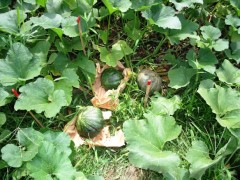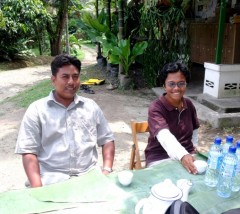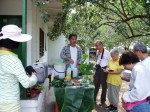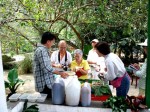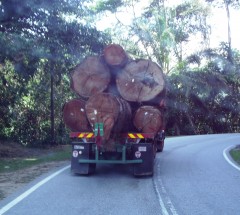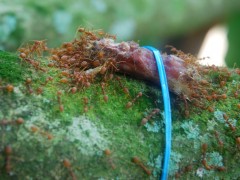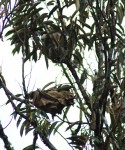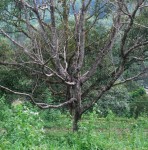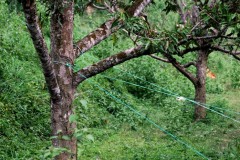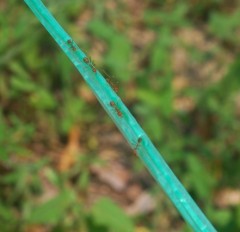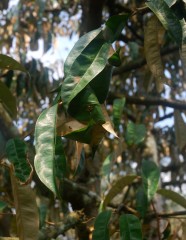Jun 29, 2009
Logging - Who Benefits? Part II
There's this report in the Star today, headlined:
Chopped down in the name of reforestation
by Geetha Krishnan
The report clearly illustrates that the people and the country do not benefit from logging. Instead it illustrates a cynical abuse of power and of our laws.
Read the full report here:
http://thestar.com.my/metro/story.asp?file=/2009/6/29/central/4206185&sec=central
09:56 Posted in Blog | Permalink | Comments (0) | Tags: the star, logging
Jun 28, 2009
Sustainable Farming
Sustainable farming in practice here:
1. This is a 'No-Dig' 35 feet x 10 feet pumpkin patch. Barely 2 months, we now have 42 pumpkins (the red tips mark the pumpkins), with more to come judging by the flowers.
2. The original soil is sandy. We build up the beds using compost, some soil and mulch.
3. Three varieties of pumpkins are planted here, creating diversity to reduce outbreaks of insect or fungal and bacterial problems. So far we have had one bacterial problem which we quickly addressed by uprooting and destroying the plant. Fungal problems have been minimal and have been addressed by quick action using cassia alata juice. Insects have not been serious. The beetle A. abdominalis is present but does not seem to cause any problems to the pumpkin plants.
4. No purchased fertiliser, or any other input have been used here. We only use our farm made compost.
5. We are now looking forward to see whether a second crop of pumpkins using the same plot of land can produce similar yields. That would really be a test of sustainability.
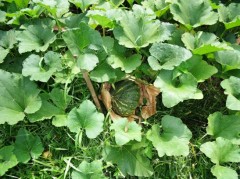
17:45 Posted in Sustainable Farming | Permalink | Comments (2) | Tags: sustainable farming, pumpkins
Jun 22, 2009
Poultry Enthusiasts
A couple of poultry enthusiasts who are also bloggers visited us today. Haslinda's blog is http://lopehpoultry.blogspot.com and Saiful's is http://citypullagro.blogspot.com
Wonder what's behind Haslinda's gleeful smile?
Qi perhaps?
18:19 Posted in Visitors | Permalink | Comments (1) | Tags: ayam kampung, bloggers
Workshop on Nature Q-Farming
We had a workshop on making bio nutrients and basics of Nature Q Farming on June 20th 2009. The workshop is meant for home food growers and not for commercial farmers. The objectives are to 1) introduce market gardening to urban dwellers to reduce the hold of commercial farmers over our lives, 2) to empower urban dwellers to take back some of the responsibility of producing healthy food for our children, and 3) to allow urban dwellers to have a source of income to offset increasing costs of living in the cities.
Participants were 'aligned' to the energy in the environment and taught how to harness the energy that is present, to enhance the energy and to incorporate the energy into the plants and vegetables that they are growing. By so doing, they give to the plants a part of their energy and in return the plants and microbes will multiply it many fold for them.

The field of energy around us.
Read 'The Field' by Lynne McTaggart.
For the first time, these 'die-hard' organic gardeners felt a living connection with the plants that they have been growing for years. We become a part of the plants and they become a part of us, in this cycle of passing of nutrients and living energy between one living organism to another; we are no longer 'eating' a plant instead we are sharing and exchanging living energy.
I can still remember the wonder on the face of one of the participants when he felt the microbes releasing energy at him. And I remember also the remark of another participant that he was wondering why he did not start panting after a fairly vigorous walk to some wild bamboo groves and back, as he was a heart patient.
An important part of Nature Q Farming is working with the plants and herbs and microbes that is in the environment.
Making brews of various friendly microbes to be used as intermediaries between us and the plants that we are growing.
18:11 Posted in Bio Nutrients | Permalink | Comments (5) | Tags: nature farming, organic farming, qi, qi farming
Jun 18, 2009
Logging - Who Benefits?
Saw this on the way back from the farm today. There were 6 of these trucks. Some of the logs must be from trees that are 80 to 100 years old.
Wish I were an economist; then it would be a simple matter of working out the numbers that nobody benefits from cutting down these trees. Not the people, not the country.
Not when you add up all the indirect, long term costs, including costs of ensuring steady supply of clean drinking water, costs of piping water from Pahang to KL, costs of mitigating landslides, loss of fisheries, cost of storm damage, etc.
Ironic isn't it, that one of the greatest loggers of all, a Malaysian, will soon be knighted by the Queen of England.
And even more ironic; on the one hand we spend millions promoting the planting of trees while on the other, we continue to hand out logging concessions.
19:00 Posted in Blog | Permalink | Comments (0) | Tags: logging, timber
Hatching Techniques
Jeremy of L.A., USA made my day with the following email:
"Thank you , Thank you , Thank you,
Here's a photo of his great hatch :
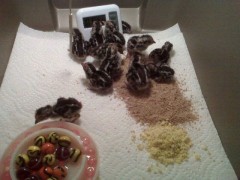

09:37 Posted in Blog | Permalink | Comments (0) | Tags: incubation, weight-loss method, hatching techniques, mountain quail
Jun 08, 2009
Kerengga - Our Organic Partners
Sceptics say, organic durians, sure? How do you handle weevils that just love durians and can easily infest 40% of your fruits? Or what about borers that kill the trees in weeks after you have lovingly taken care of the trees for years? And squirrels, they love the durians, so what do you do, kill them?
Well, we have a few hundred durian and mango trees and we will tell you it's almost impossible (the labour costs will be too high) if not for our "friendly" neighbourhood kerengga ( weaver ants, or oecophylla smaragdina )
Gang of carnivorous kerengga attacking a piece of meat. Meat is used to establish a colony in a new tree.
Kerengga nests the size of large durians.
A tree killed by borers.
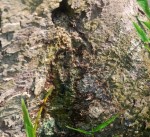
A borer hole that's dry after kerengga cleaned out the borers
Highway of raffia strings for the weaver ants to form a colony of 20 to 30 trees around one central tree.
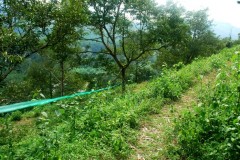
Using the highway
New weaver ant nests as they colonise a new tree.
Once the weaver ants colonise a tree, the borers are gone. Weevil infested fruits and squirrel attacks are almost non-existent. That gives us time to focus on the other major problem with durian trees – phytoptera attacks, for which sadly, we have no answer as yet.
19:59 Posted in Sustainable Farming | Permalink | Comments (2) | Tags: weaver ants, natural enemies









